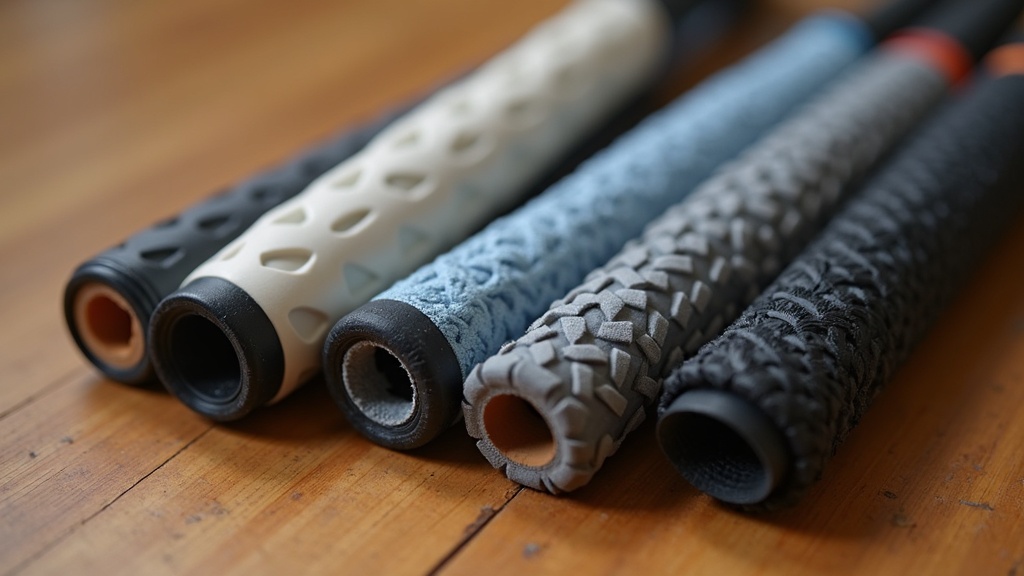If you play golf often, you know that the grip is the only point where you physically connect with your club. Picking the right grip material for your clubs can really change how confident and comfortable you feel on the course. There are tons of grip options out there, with different materials built to match specific swings and weather preferences. I’ll walk you through the most popular materials, their pros and cons, and how your play style can steer your choice.

Why Grip Material Even Matters
The material in your golf grip affects everything from how secure your hold feels on a humid day to how much feedback you get from the clubface at impact. I’ve noticed that sometimes, what feels really comfortable in the store might not actually hold up well after a few sweaty summer rounds or during a rainy morning. That’s why thinking about grip material isn’t just about personal taste – it’s about matching your equipment to how you play and where you play.
Golf grip technology has changed a lot over the years. Modern options offer cool features like moisture wicking, tacky surfaces, and extra cushioning for players who need it. Brands now compete to develop materials that can handle any conditions while lasting longer than older grips from decades ago. That’s especially useful if you play in different climates, or just want a set of grips that won’t force you to regrip your clubs every season. These advancements mean you can really find a grip that fits your needs, no matter how or where you typically play.
Main Types of Golf Grip Materials
There are three main grip material categories you’ll see in pro shops and online:
- Rubber Grips: The most common choice, seen on lots of stock clubs and preferred by many casual and serious golfers.
- Corded Grips: These mix rubber with woven cords for extra traction, and are favored by players with aggressive swings or those who play in wet conditions.
- Synthetic and Hybrid Grips: Made from advanced composites or polyurethane blends, these aim to deliver specific features like comfort, performance, and durability.
Each comes with a different feel, level of tackiness, and price tag. It helps to get familiar with how these materials perform in the real world and understand which might be best for your particular approach to the game.
Getting to Know Each Golf Grip Material
I’ve tried rubber, corded, and synthetic grips, so here’s how I think they stack up for different golfers:
- Rubber Grips: Super common and easy to get used to. They offer a soft, consistent feel, and work for most skill levels. Rubber grips are generally affordable and come in a huge variety of textures and firmness. If you want something low maintenance and versatile, rubber grips make sense. They can get slippery in rain or sweat unless you pick a model with extra tack or texture.
- Corded Grips: Cord grips are a staple for players who like to swing hard. They weave rough, corded threads into the rubber, giving you a gritty texture that won’t let go, even in rough weather. I’ve reached for these when playing in wet or humid conditions. The trade-off is that corded grips can be tougher on your hands, especially after long practice sessions. They suit players with firmer swings or who want maximum control.
- Synthetic and Hybrid Grips: If you like technology and care about feel, synthetic options are worth checking out. They come in multiple layers—soft outer surfaces with firm understructures, or hybrids that use cord only where your upper hand goes. Synthetics are pretty good at staying tacky and comfortable, even as the weather changes. Some players find the cushioned feel helps if you get hand fatigue. Plus, hybrid options provide a blend of grip and comfort, appealing to those who want a little of both worlds.
How to Match Grip Material With Your Playing Style
Your playing style, whether you’re aggressive off the tee or prefer a steady, controlled tempo, matters a lot when picking a grip. Here are a few tips based on situations I’ve seen on the course:
- If you sweat a lot or play in the rain: Corded or cordhybrid grips help maintain traction. The texture presses into your hands and keeps you from losing your grip during tough shots.
- If you want soft feel and forgiveness: Rubber or multilayer synthetic grips can really work, absorbing more of the club’s vibrations. That helps if you have hand issues or just value comfort over pure feedback.
- If you swing hard and want maximum control: Corded grips are reliable here. The rough texture supports aggressive swings without slipping.
- If consistency is your focus: Any high quality grip will work, but make sure you factor in how the feel changes over time. Some softer materials lose tackiness faster and could throw off your routine round after round.
RealWorld Things That Matter When Choosing Your Grip
Picking a golf grip isn’t just about material. It’s about what happens when you actually use your clubs. Here’s what I always keep in mind:
- Climate and Weather: Warm, sweaty hands or rainy days call for more tack or texture. In drier climates, comfort and feel might take the lead over moisture control.
- Glove or No Glove: Some grips feel much better barehanded while others pair well with gloves. I’ve found that corded grips can chew through gloves pretty fast, while soft synthetics or rubber feel just fine either way.
- Grip Size and Texture: Material affects not just how the grip feels, but which textures and sizes are available. Thicker rubber grips help some players steady their hands, while slim, textured grips give feedback on every shot.
- Maintenance: Soft or tacky synthetics need cleaning to keep their grip. Corded grips collect dirt fast but can be cleaned with soapy water. Keeping all grips clean extends their life, no matter the material.
Grip Material and Wear
I’ve seen even the best grips get worn out from regular play. Generally, softer rubber grips lose tackiness quickest, especially if you play a ton. Corded grips hold up well but can fray or feel rougher as they wear down. Synthetics and hybrids usually last the longest if you keep them clean. If you play multiple times per week, check your grips regularly for signs of wear, discoloration, or loss of tackiness. Swapping out grips before they become a problem can prevent missed shots and frustration on the course.
Comfort Versus Feedback
Some players want to feel every vibration through the shaft, so they go for firmer corded or basic rubber grips. Others like a grip that softens the shock of mishits. If comfort is your top priority, softer synthetic grips or rubber with added cushioning are worth a look. Trying out a few at a golf shop can help you figure out what actually feels best in your swing. Don’t hesitate to ask the staff to let you practice a few swings, since even subtle differences in feel can become more noticeable over a full round.
My Top Suggestions for Specific Golf Grip Situations
- For Most Golfers (Balanced Comfort and Control): Standard rubber grips with medium texture.
- For Rainy or Humid Play: Full cord or hybrid cord grips for extra traction and maximum security during wet weather.
- For Arthritic Hands or Maximum Comfort: Oversized, soft synthetic grips that reduce vibration shock and make swinging less demanding on your joints.
- For Advanced Players After FineTuned Feedback: Firm, thin cord grips or highend rubber for every detail from the clubhead to your palms.
Brands like Golf Pride, Lamkin, and Winn each have specialty options to fit your preferences. If you’re looking for durability, Golf Pride’s Tour Velvet or Lamkin’s Crossline are two that have done well for me in multiple conditions. Winn’s Dri-Tac synthetic grips also get high marks from players looking for softness and water resistance. As always, the best choice is one that matches your hands, playing style, and the climate you spend most of your rounds in.
Frequently Asked Questions
Here are some questions I often get from golfers about grip material:
Question: How often should I replace my grips?
Answer: For regular players, new grips every year is a good habit. If your grips start feeling slick or your hands slip, it’s probably time to switch, even sooner.
Question: Do thicker grips help control slices or hooks?
Answer: Sometimes, yes. A thicker grip can make it harder to flip your wrists through impact, which helps some players keep the clubface more stable. It won’t magically fix swing flaws, but it helps reduce extreme hand movement.
Question: Can I mix different grip materials on my set?
Answer: It’s not unheard of. Some players use corded grips for woods and hybrids but go for smooth rubber or synthetic on their irons for extra touch. Just make sure the difference doesn’t throw off your consistency.
Comfort and Confidence Go Hand-in-Hand With The Right Grip
Picking the right golf grip material boosts your confidence and can help smooth out little bumps in your swing. I always suggest testing a few styles before swapping out all your clubs. Thinking about your preferences, and maybe giving a couple grip materials a trial run at your local shop or during a fitting, can pay off in comfort and control right away. The grip you settle on should feel like a natural extension of your hands, ready for any weather or pressure shot you might face out there. Remember to clean your grips and replace them before they get too worn, and you’ll see benefits both in your scores and your enjoyment of the game. Finding the grip that matches your hands and habits is one of the simplest ways to make the game easier and more fun.
